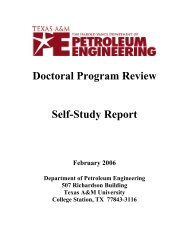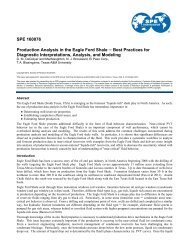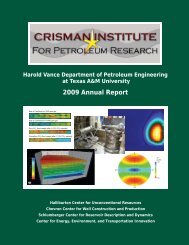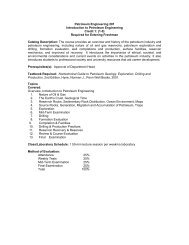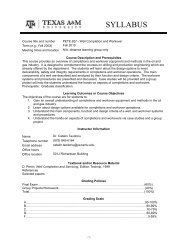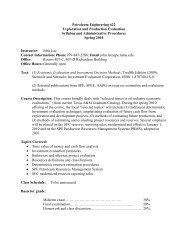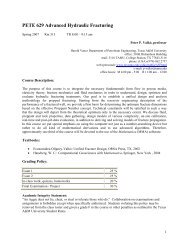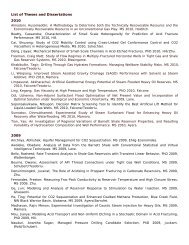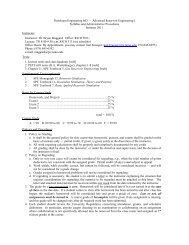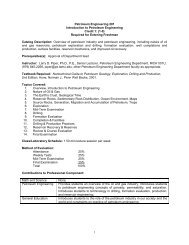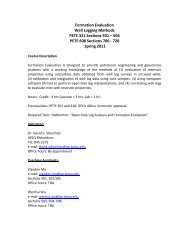Comparison of Sequence Accelerators for the Gaver Method of ...
Comparison of Sequence Accelerators for the Gaver Method of ...
Comparison of Sequence Accelerators for the Gaver Method of ...
Create successful ePaper yourself
Turn your PDF publications into a flip-book with our unique Google optimized e-Paper software.
ELSEVIER<br />
Available ontine at www.sciencedirect.com<br />
"CIENOE~OIREOT e<br />
An International Joumal<br />
computers &<br />
ma<strong>the</strong>matics<br />
with applications<br />
Computers and Ma<strong>the</strong>matics with Applications 48 (2004) 629-636<br />
www.elsevier.com/locate/camwa<br />
<strong>Comparison</strong> <strong>of</strong> <strong>Sequence</strong> <strong>Accelerators</strong> <strong>for</strong><br />
<strong>the</strong> <strong>Gaver</strong> <strong>Method</strong> <strong>of</strong><br />
Numerical Laplace Trans<strong>for</strong>m Inversion<br />
P. P. VALKO<br />
Department <strong>of</strong> Petroleum Engineering<br />
Texas A&M University<br />
College Station, TX 77843, U.S.A.<br />
p-valko©tamu, edu<br />
J. ABATE<br />
900 Hammond Road<br />
Ridgewood, NJ 07450-2908, U.S.A.<br />
(Received August 2002; revised and accepted October 2002)<br />
Abstract--The sequence <strong>of</strong> <strong>Gaver</strong> functionals is useful in <strong>the</strong> numerical inversion <strong>of</strong> Laplace<br />
trans<strong>for</strong>ms. The convergence behavior <strong>of</strong> <strong>the</strong> sequence is logarithmic, <strong>the</strong>re<strong>for</strong>e, an acceleration<br />
scheme is required. The accepted procedure utilizes Salzer summation, because in many cases <strong>the</strong><br />
<strong>Gaver</strong> functionals have <strong>the</strong> asymptotic behavior f,~(t) - f~-l(t) N An -2 as n --* oo <strong>for</strong> fixed t. It<br />
seems that no o<strong>the</strong>r acceleration schemes have been investigated in this area. Surely, <strong>the</strong> popular<br />
nonlinear methods should be more effective. However, to our surprise, only one nonlinear method<br />
was superior to Salzer summation, namely <strong>the</strong> Wynn rho algorithm. (~) 2004 Elsevier Ltd. All rights<br />
reserved.<br />
Keywords--Convergence acceleration, <strong>Sequence</strong> trans<strong>for</strong>mation, Laplace trans<strong>for</strong>m, Numerical<br />
trans<strong>for</strong>m inversion.<br />
1. INTRODUCTION<br />
The sequence <strong>of</strong> <strong>Gaver</strong> functionals is useful in <strong>the</strong> numerical inversion <strong>of</strong> Laplace trans<strong>for</strong>ms. The<br />
convergence behavior <strong>of</strong> <strong>the</strong> sequence is logarithmic, <strong>the</strong>re<strong>for</strong>e, an acceleration scheme is required.<br />
The so-called <strong>Gaver</strong>-Stehfest method utilizes Salzer summation to accelerate convergence. The<br />
Salzer summation is one <strong>of</strong> <strong>the</strong> so-called linear acceleration methods and can be considered as <strong>the</strong><br />
optimal method within that family, as explained in a recent review by Frolov and Kitaev [1]. The<br />
purpose <strong>of</strong> this paper is to examine <strong>the</strong> per<strong>for</strong>mance <strong>of</strong> some nonlinear sequence trans<strong>for</strong>mations<br />
applied to <strong>the</strong> <strong>Gaver</strong> functionals, namely,<br />
• Wynn's rho algorithm<br />
• Levin's u-trans<strong>for</strong>mation<br />
• Lubkin's iterated w-trans<strong>for</strong>mation<br />
• Brezinski's <strong>the</strong>ta algorithm<br />
0898-1221/04/$ - see front matter Q 2004 Elsevier Ltd. All rights reserved. Typeset by .A~S-TEX<br />
doi:10.1016/j.camwa.2002.10.017
630 P.P. VALKb AND J. ABATE<br />
In Section 2, we introduce <strong>the</strong> <strong>Gaver</strong> functionals and discuss <strong>the</strong>ir convergence behavior. In Section<br />
3, we present <strong>the</strong> convergence acceleration methods. The results <strong>of</strong> <strong>the</strong> numerical examples<br />
are given in Section 4.<br />
2. THE GAVER FUNCTIONALS<br />
The problem <strong>of</strong> numerical inversion <strong>of</strong> <strong>the</strong> Laplace trans<strong>for</strong>m is to obtain approximations<br />
<strong>for</strong> f(t) when numerical values <strong>of</strong> <strong>the</strong> trans<strong>for</strong>m function<br />
](s) = e-S'f(t) dt (I)<br />
fO °~<br />
can be computed. There are many methods available to solve this problem. A comprehensive<br />
list <strong>of</strong> references is available on <strong>the</strong> web, see [2].<br />
One <strong>of</strong> <strong>the</strong> most powerful and proven methods involves using <strong>the</strong> so-called <strong>Gaver</strong> functionals<br />
(see [3]), which are given by<br />
fk(t)=(--1)kTk(2:)Akf(kr)=k~'(2:)<br />
k<br />
j=O<br />
where T = ln(2)/t and A is <strong>the</strong> <strong>for</strong>ward difference operator, i.e.,<br />
A/(n~-) = f((n + 1)T) -- ?(nr).<br />
Stehfest [4] suggested a reliable inversion algorithm based on (2). For a recent per<strong>for</strong>mance<br />
analysis <strong>of</strong> <strong>the</strong> algorithm <strong>the</strong> reader is referred to [5].<br />
Under certain conditions <strong>the</strong> sequence <strong>of</strong> <strong>Gaver</strong> functionals converges logarithmically, that is<br />
lira f(t) - fk+i(t) = 1. (3)<br />
k--,~ f(t) - A(t)<br />
In fact, <strong>Gaver</strong> [3] showed that if f(t) is representable by a Taylor series <strong>for</strong> all t > 0, f~(t) has<br />
<strong>the</strong> convergence behavior<br />
c~(t)<br />
c:(t)<br />
fk(t) ,,~ f(t) + 7 + ~ +"" as k -~ ~, (4)<br />
<strong>for</strong> fixed t.<br />
To illustrate <strong>the</strong> asymptotic <strong>for</strong>m (4), we consider some examples selected from Table 1. We<br />
compute <strong>the</strong> quantity k(f(t) - fk(t)) <strong>for</strong> various values <strong>of</strong> k at fixed t. Table 2 displays <strong>the</strong>se<br />
calculations and shows that condition (3) is satisfied <strong>for</strong> <strong>the</strong> examples.<br />
Note that F10 and Fll in Table 1 are not bona fide trans<strong>for</strong>m pairs. That is, <strong>the</strong> <strong>for</strong>ward<br />
trans<strong>for</strong>m (1) <strong>of</strong> f(t) - 1/t does not exist. However, <strong>the</strong>re is a sense in which <strong>the</strong> inverses <strong>of</strong><br />
F10 and Fll are valid see [6, p. 62]. It is reasonable to expect that a good numerical inversion<br />
method should be able to handle <strong>the</strong>se so-called pseudotrans<strong>for</strong>ms.<br />
The <strong>Gaver</strong> functionals (2) can also be obtained by a recursive algorithm, ms follows:<br />
G(o ~) = nT](n~'),<br />
.fk(t) = a (k), k<br />
Tt<br />
~k--I '<br />
n~_l,<br />
k > 1, n > k, (5)<br />
see [3, p. 450].
Numerical Laplace Trans<strong>for</strong>m Inversion 531<br />
Table 1. The test set <strong>of</strong> trans<strong>for</strong>ms and <strong>the</strong>ir inverses.<br />
ID<br />
F01<br />
F02<br />
F03<br />
F04<br />
Fo5<br />
F06<br />
F07<br />
](s)<br />
1<br />
l+s 2<br />
1<br />
vq+ vT-~ 1<br />
1<br />
1<br />
,/7(1 + v~)<br />
e~p (-2v~)<br />
exp (-~) cos<br />
.,Z<br />
exp(-1/s)<br />
f(t)<br />
sin t<br />
l_e-t<br />
2~v~<br />
:c~Sc (:)<br />
e-llt<br />
cos (1/2t)<br />
v~7<br />
sin 2V~<br />
F08<br />
F09<br />
F10*<br />
Fll*<br />
- in(s)<br />
$<br />
e s K1 (s)<br />
S<br />
i (ln(s))2<br />
s ~ ln(s)<br />
* Pseudotrans<strong>for</strong>ms<br />
v~+2)<br />
In(t) + ~,<br />
t<br />
6<br />
t 4<br />
Table 2. Estimate <strong>of</strong> Cl ($) in (4) <strong>for</strong> t = 3.<br />
k FOl F03 F06 F08 F10<br />
4 0.653 0.0287 0.0610 -0.541 0.188<br />
8 1.55 0.0267 0.0589 -0.551 0.185<br />
16 2.49 0.0256 0.0580 -0.557 0.184<br />
32 3.14 0.0251 0.0577 -0.559 0.183<br />
64 3.50 0.0249 0.0575 -0.560 0.183<br />
128 3.68 0.0248 0.0575 -0.561 0.183<br />
256 3.78 0.0247 0.0574 -0.561 0.183<br />
3. SEQUENCE TRANSFORMATIONS<br />
To examine <strong>the</strong> acceleration <strong>of</strong> convergence <strong>for</strong> <strong>the</strong> <strong>Gaver</strong> functionals, we consider five sequence<br />
trans<strong>for</strong>mations. A study <strong>of</strong> <strong>the</strong> literature on methods, which accelerate logarithmically<br />
convergent sequences (see [7-15]) indicates that <strong>the</strong> five methods chosen are considered <strong>the</strong> best<br />
available <strong>for</strong> sequences that exhibit <strong>the</strong> asymptotic behavior given by (4).<br />
The book by Wimp [7] provides a nice introduction to all <strong>the</strong> methods considered herein.<br />
The early comparison studies <strong>of</strong> Smith and Ford [8-10] were favorably disposed to Levin's<br />
u-trans<strong>for</strong>mation and Brezinski's <strong>the</strong>ta algorithm. On <strong>the</strong> o<strong>the</strong>r hand, Weniger [11-13] found<br />
Lubkin's iterated w-trans<strong>for</strong>mation to be effective. Van Tuyl [14] and Osada [15] determined that<br />
Wynn's rho algorithm also works effectively.<br />
Note, <strong>the</strong>re seems to be no universal "best" method <strong>for</strong> logarithmically convergent sequences,<br />
see [16,17].
632 P.P. VALK6 AND J. ABATE<br />
3.1. Salzer Summation and <strong>the</strong> Neville Table<br />
Salzer summation is a linear method. The approximant <strong>for</strong> f(t) is given by<br />
where <strong>the</strong> weights are<br />
M<br />
f(t,M) = E wksk(t),<br />
k=l<br />
(l~k+MkM (M)<br />
w~ = ,-, ~.w , (7)<br />
see [7, pp. 35-38]. Approximant (6) is known as <strong>the</strong> <strong>Gaver</strong>-Stehfest method [4] <strong>for</strong> numerical<br />
inversion <strong>of</strong> Laplace trans<strong>for</strong>m. The acceleration method itself may be viewed as a special ease<br />
<strong>of</strong> <strong>the</strong> Richardson extrapolation process, see [4]. As such, it has been widely known prior to 1955<br />
when Salzer presented his weights (7). It was previously given by a recursive scheme, known as<br />
<strong>the</strong> Neville table and also referred to as <strong>the</strong> Neville-Aitken extrapolation process. An equivalent<br />
recursive scheme is given by<br />
T(o ~) = f~(t),<br />
Tk (~) (1 + k)~r(~+l)(k) "tk--1 -- q'('0 ~k--l'<br />
see [7, p. 75]. Then, <strong>the</strong> approximant f(t, M) = T(~ ).<br />
n>0,<br />
k_>l,<br />
(6)<br />
(s)<br />
3.2. Wynn's Rho Algorithm<br />
The Wynn rho algorithm is given by<br />
pt~ = 0,<br />
p(k~) _ ,,(~+1)<br />
-- t'k-2 -4-<br />
p~o ~) = S~(t),<br />
k<br />
see [7, p. 168]. The approximant f(t, 2m) = .(o) Y2rn •<br />
p(n+l) _ P~)l'<br />
k-1<br />
n>0,<br />
k>l,<br />
(9)<br />
3.3. Levin's u-Trans<strong>for</strong>mation<br />
Levin's u-trans<strong>for</strong>mation is given by<br />
where <strong>the</strong> weights are<br />
Wk -= (--1)kk M-2<br />
M<br />
E WkA(t)<br />
f(t,M) = k=l (10)<br />
M<br />
EW~<br />
k=l<br />
fk(t) -- fk-l(t)'<br />
see [8, p. 227] and also [7, p. 193]. Also, <strong>the</strong>re is a recursive scheme <strong>for</strong> <strong>the</strong> Levin u-trans<strong>for</strong>mation,<br />
see [10,11,18]. Note that <strong>the</strong> Levin u-trans<strong>for</strong>mation has <strong>the</strong> same structure as <strong>the</strong> Salzer summation.<br />
Indeed, if in (11) we let fk(t) -- fk-l(t) = 1/k 2 <strong>the</strong>n (10) is equivalent to (6) and (7).<br />
3.4. Lubkin's Iterated W-Trans<strong>for</strong>mation<br />
The Lubkin iterated w-trans<strong>for</strong>mation is given by<br />
w0 (n) = fn(t), n > 0,<br />
(~w~) (~w: +1) (z~w~ +1) k > 0, (12)<br />
+1 (~w; +2) (~2w~) - (z~w~) (A2w;+I) '<br />
where A is <strong>the</strong> <strong>for</strong>ward difference operator acting on <strong>the</strong> superscript n; see [7, p. 152; 14, p. 231].<br />
This method is also called <strong>the</strong> Brezinski iterated <strong>the</strong>ta algorithm, see [13, p. 342]. Then, <strong>the</strong><br />
approximant f(t, 3m) = W(m °).
3.5. Brezinski's Theta Algorithm<br />
The Brezinski <strong>the</strong>ta algorithm is given by<br />
Numerical Laplace Trans<strong>for</strong>m Inversion 633<br />
= 0, 0o<br />
n>_0,<br />
,~(,~) _ gn+l) I<br />
v2k+l -- ~2k-1 -~ A/:}(n ) '<br />
~v2k<br />
kk0,<br />
D(n-l-2) AD(n+I) D(n+I)AD(n)<br />
0(n) v2k ~2k+l -- ~2k "~"2k+l<br />
2k+e = A20(~)<br />
2k+l<br />
,<br />
k>0<br />
(13)<br />
see [7, p. 171]. The approximant f(t, 2m) = 0(°)2,=. Note that 0 (~) = W (n+l), which is why <strong>the</strong><br />
Lubkin scheme (12) is also called <strong>the</strong> iterated <strong>the</strong>ta algorithm, see [7, p. 171].<br />
4. RESULTS<br />
We use multiprecision computing provided by Ma<strong>the</strong>matica. Table 3 shows <strong>the</strong> accuracy (number<br />
<strong>of</strong> significant digits) in <strong>the</strong> result <strong>of</strong> <strong>the</strong> approximant f(t, M) at t = 0.3 with M = 24. To<br />
create <strong>the</strong> table, we used 50 decimal digits <strong>of</strong> precision.<br />
Table 3. Number <strong>of</strong> significant digits obtained in acceleration <strong>of</strong> convergence <strong>for</strong> each<br />
method at t = 0.3, M = 24, and precision = 50.<br />
Salzer<br />
F01 22 23<br />
F02 23 25<br />
F03 24 25<br />
F04 23 23<br />
F05 11 12<br />
F06 5 6<br />
F07 23 24<br />
F08 23 24<br />
F09 23 25<br />
F10 22 24<br />
Fll 7 24<br />
Wynn Rho Levin U Lubkin W Brezinski Theta<br />
20<br />
21<br />
20<br />
21<br />
9<br />
1<br />
11<br />
20<br />
20<br />
20<br />
6<br />
Repeating <strong>the</strong> exercise <strong>for</strong> t = 3, 30, and 300, Tables 4-6 were created in a similar manner.<br />
The results show remarkable consistency in <strong>the</strong> sense that <strong>the</strong> relative per<strong>for</strong>mance <strong>of</strong> any two<br />
methods remain basically <strong>the</strong> same, regardless which trans<strong>for</strong>m we look at. Though testing a<br />
limited set <strong>of</strong> trans<strong>for</strong>ms and time points always leaves some possibility <strong>for</strong> erroneous generalization,<br />
<strong>the</strong> results lead us to conclude, that <strong>for</strong> accelerating <strong>the</strong> convergence <strong>of</strong> <strong>Gaver</strong> functionals<br />
two methods per<strong>for</strong>m significantly better than <strong>the</strong> o<strong>the</strong>rs: <strong>the</strong> Salzer summation and Wynn's rho<br />
algorithm. In fact, we have more extensive computational experience to support this statement.<br />
We have tested <strong>the</strong>se algorithms on <strong>the</strong> set <strong>of</strong> 105 trans<strong>for</strong>ms defined as Test Set A in [5]. The<br />
results <strong>of</strong> <strong>the</strong> extensive testing ef<strong>for</strong>t are similar to those given herewith in Tables 3-6. The<br />
trans<strong>for</strong>ms in Table 1 can be considered as a good representative sample <strong>of</strong> <strong>the</strong> larger set <strong>of</strong> 105<br />
test pairs.<br />
These two algorithms also have <strong>the</strong> property that with increasing M <strong>the</strong> number <strong>of</strong> correct<br />
decimals is increasing approximately linearly. To illustrate this point, we show results <strong>for</strong> t = 300<br />
with doubled M (and precision) in Table 7. We note, however, that <strong>the</strong> Levin u algorithm,<br />
though always somewhat less effective than <strong>the</strong> Salzer summation, also exhibits linear increase<br />
<strong>of</strong> accuracy with <strong>the</strong> increase <strong>of</strong> M.<br />
Note that in all <strong>the</strong> considered algorithms <strong>the</strong> overwhelming part <strong>of</strong> <strong>the</strong> computational ef<strong>for</strong>t<br />
is related to <strong>the</strong> multiprecision evaluation <strong>of</strong> <strong>the</strong> <strong>Gaver</strong> functionals. The slight difference in <strong>the</strong><br />
13<br />
14<br />
11<br />
15<br />
4<br />
1<br />
9<br />
18<br />
11<br />
15<br />
8<br />
14<br />
14<br />
11<br />
15<br />
4<br />
1<br />
7<br />
18<br />
13<br />
15<br />
8
634 P. P. VALKO AND J. ABATE<br />
Table 4. Number <strong>of</strong> significant digits obtained in acceleration <strong>of</strong> convergence <strong>for</strong> each<br />
method at t = 3, M =- 24, and precision = 50.<br />
Salzer<br />
F01 11 15<br />
F02 21 24<br />
F03 17 24<br />
F04 22 24<br />
F05 12 14<br />
F06 11 15<br />
F07 20 22<br />
F08 23 25<br />
F09 21 24<br />
F10 23 25<br />
Fll 7 24<br />
Wynn Rho Levin U Lubkin W Brezinski Theta<br />
0<br />
4<br />
12<br />
19<br />
11<br />
10<br />
7<br />
21<br />
18<br />
21<br />
6<br />
Table 5. Number <strong>of</strong> significant digits obtained in acceleration <strong>of</strong> convergence <strong>for</strong> each<br />
method at t -- 30, M -- 24, and precision -- 50.<br />
Salzer Wynn Rho Levin U Lubkin W Brezinski Theta<br />
0<br />
5<br />
6<br />
13<br />
6<br />
10<br />
7<br />
19<br />
14<br />
17<br />
8<br />
0<br />
5<br />
7<br />
15<br />
5<br />
10<br />
2<br />
18<br />
13<br />
16<br />
8<br />
F01 0 0<br />
F02 12 14<br />
F03 13 13<br />
F04 20 22<br />
F05 14 18<br />
F06 15 19<br />
F07 14 16<br />
F08 23 25<br />
F09 21 22<br />
F10 23 25<br />
Fll 7 24<br />
0<br />
10<br />
11<br />
19<br />
13<br />
14<br />
9<br />
21<br />
19<br />
21<br />
6<br />
0<br />
8<br />
8<br />
14<br />
10<br />
11<br />
5<br />
19<br />
16<br />
14<br />
8<br />
0<br />
8<br />
8<br />
10<br />
8<br />
14<br />
2<br />
19<br />
15<br />
14<br />
8<br />
Table6. Number <strong>of</strong> significant digits obtained in acceleration <strong>of</strong> convergence <strong>for</strong> each<br />
method at t = 300, M ---- 24, and precision = 50.<br />
Salzer<br />
Wynn Rho<br />
Levin U<br />
Lubkin W<br />
Brezinski Theta<br />
F01 0 0<br />
F02 13 16<br />
F03 16 19<br />
F04 21 22<br />
F05 17 20<br />
F06 20 22<br />
F07 1 0<br />
F08 24 25<br />
F09 22 23<br />
F10 23 25<br />
Fll 7 24<br />
0<br />
12<br />
15<br />
19<br />
15<br />
18<br />
0<br />
21<br />
20<br />
22<br />
7<br />
0<br />
10<br />
13<br />
16<br />
12<br />
16<br />
0<br />
19<br />
15<br />
16<br />
8<br />
0<br />
10<br />
14<br />
17<br />
8<br />
16<br />
0<br />
19<br />
15<br />
15<br />
8<br />
actual number <strong>of</strong> arithmetic operations during <strong>the</strong> sequence acceleration process is negligible.<br />
There<strong>for</strong>e, <strong>the</strong> overall effectiveness <strong>of</strong> an inversion method based on <strong>the</strong> <strong>Gaver</strong> functionals would<br />
be primarily determined by <strong>the</strong> necessary number <strong>of</strong> terms (M) and by <strong>the</strong> required precision<br />
that is related to M.<br />
In <strong>the</strong> following, we concentrate only on <strong>the</strong> two outstanding per<strong>for</strong>mers. The Salzer summation<br />
needs approximately 2M precision while <strong>the</strong> Wynn rho algorithm needs 2.1M. Note
Numerical Laplace Trans<strong>for</strong>m Inversion<br />
635<br />
Table 7. Number <strong>of</strong> significant digits obtained in acceleration <strong>of</strong> convergence <strong>for</strong> each<br />
method at t -- 300, M = 48, and precision = 50.<br />
F01 0<br />
F02 24<br />
F03 28<br />
F04 40<br />
F05 35<br />
F06 38<br />
F07 16<br />
F08 46<br />
F09 42<br />
F10 45<br />
Fll 32<br />
Salzer Wynn Rho Levin U Lubkin W Brezinski Theta<br />
0 0<br />
29 23<br />
32 27<br />
44 38<br />
42 34<br />
43 37<br />
22 0<br />
49 44<br />
44 41<br />
48 44<br />
44 30<br />
0 0<br />
13 13<br />
20 21<br />
20 20<br />
17 14<br />
23 19<br />
0 0<br />
20 22<br />
17 16<br />
20 23<br />
12 17<br />
Table 8. Inversion <strong>of</strong> F01 at various t values using M = 80 + t.<br />
t<br />
3O<br />
6O<br />
90<br />
150<br />
3O0<br />
600<br />
9OO<br />
1500<br />
3000<br />
M Salzer WynnRho<br />
110 22 40<br />
140 13 28<br />
170 9 23<br />
230 6 19<br />
380 3 19<br />
680 1 18<br />
980 i 22<br />
1580 2 29<br />
3080 0 50<br />
that <strong>the</strong>se rules were obtained by detailed numerical experimentation. Since <strong>the</strong> small deviation<br />
in <strong>the</strong> required precision is not significant, <strong>the</strong> final outcome <strong>of</strong> <strong>the</strong> per<strong>for</strong>mance comparison is<br />
determined by <strong>the</strong> number <strong>of</strong> terms necessary to reach a certain accuracy goal. The difference<br />
in per<strong>for</strong>mance <strong>of</strong> <strong>the</strong> Salzer summation and <strong>the</strong> Wynn rho algorithm is illustrated here by a<br />
somewhat artificial but very in<strong>for</strong>mative numerical experiment involving <strong>the</strong> most demanding<br />
trans<strong>for</strong>m, F01: <strong>for</strong> increasing t values we increase <strong>the</strong> M value linearly and compare <strong>the</strong> convergence<br />
behavior. In particular, we use M = 80 + t terms, while <strong>the</strong> precision <strong>of</strong> <strong>the</strong> calculations is<br />
increased accordingly. The results are shown in Table 8.<br />
The sine function is <strong>of</strong> course notoriously difficult to obtain from its trans<strong>for</strong>m. Never<strong>the</strong>less,<br />
<strong>the</strong> Wynn rho algorithm shows remarkable consistency even in this case, indicating that to achieve<br />
a fixed accuracy <strong>of</strong> <strong>the</strong> inverse, <strong>the</strong> necessary M increases maximum linearly with t. Based on<br />
our experience, <strong>the</strong> Wynn rho algorithm outper<strong>for</strong>ms <strong>the</strong> Salzer summation <strong>for</strong> accelerating <strong>the</strong><br />
convergence <strong>of</strong> <strong>the</strong> <strong>Gaver</strong> functionals. So far we could not find any substantial counter example<br />
to this statement.<br />
5. CONCLUSIONS<br />
The results lead us to believe that <strong>for</strong> <strong>the</strong> convergence acceleration <strong>of</strong> <strong>the</strong> <strong>Gaver</strong> functionals <strong>the</strong><br />
Wynn rho algorithm is <strong>the</strong> most effective among <strong>the</strong> acceleration schemes considered in this work.<br />
The reliable per<strong>for</strong>mance <strong>of</strong> <strong>the</strong> Wynn rho algorithm is predicted by a <strong>the</strong>orem by Osada 1119]<br />
that ensures <strong>the</strong> convergence if condition (4) is satisfied. In our numerical investigation <strong>the</strong><br />
Lubkin iterated trans<strong>for</strong>mation and <strong>the</strong> Brezinski <strong>the</strong>ta algorithm per<strong>for</strong>med worse than we had<br />
anticipated based on <strong>the</strong> views regarding <strong>the</strong>ir "across <strong>the</strong> board" properties. For example, see<br />
Section 5.2 <strong>of</strong> [19]. A reasonable explanation to our finding might have been that <strong>the</strong> number <strong>of</strong>
636 P.P. VALKO AND J. ABATE<br />
arithmetic operations during <strong>the</strong> acceleration process is somewhat less in <strong>the</strong> Salzer and Wynn rho<br />
algorithms than in <strong>the</strong> o<strong>the</strong>r three. However, <strong>the</strong> accuracy indicated <strong>for</strong> a given M in Tables 2-6<br />
is already "final" in <strong>the</strong> sense, that any fur<strong>the</strong>r increase <strong>of</strong> <strong>the</strong> precision leaves <strong>the</strong> number <strong>of</strong><br />
significant digits intact. In o<strong>the</strong>r words, <strong>the</strong> difference in per<strong>for</strong>mance has a deeper cause than<br />
<strong>the</strong> appearance and propagation <strong>of</strong> numerical error due to round-<strong>of</strong>f and computer arithmetic.<br />
Some <strong>of</strong> <strong>the</strong> results indicate that <strong>the</strong>re may exist a nice error estimate <strong>for</strong> <strong>the</strong> Wynn rho<br />
algorithm, namely,<br />
Un<strong>for</strong>tunately, we are unable to determine a precise set <strong>of</strong> conditions when <strong>the</strong> error estimate is<br />
valid. This is an open question which we are pursuing.<br />
REFERENCES<br />
1. G.A. Frolov and M.Y. Kitaev, Improvement <strong>of</strong> accuracy in numerical methods <strong>for</strong> inverting Laplace trans<strong>for</strong>ms<br />
based on <strong>the</strong> Post-Widder <strong>for</strong>mula, Computers Math. AppIic. 36 (5), 23-34, (1998).<br />
2. P.P. Valk6 and B.L. Vojta, The list, http://pumpjack.tamu.edu/,.~valko, (2001).<br />
3. D.P. <strong>Gaver</strong>, Jr., Observing stochastic processes and approximate trans<strong>for</strong>m inversion, Oper. Res. 14, 444-459,<br />
(1966).<br />
4. H. Stehfest, Algorithm 368: Numerical inversion <strong>of</strong> Laplace Trans<strong>for</strong>ms, Comm. ACM 13, 47-49 and 624,<br />
(1970).<br />
5. P.P. Valk5 and S. Vajda, Inversion <strong>of</strong> noise-flee Laplace trans<strong>for</strong>ms: Towards a standardized set <strong>of</strong> test<br />
problems 7 Inverse Problems in Engineering 10, 467-483, (2002).<br />
6. G. Doetsch, Introduction to <strong>the</strong> Theory and Application <strong>of</strong> <strong>the</strong> Laplace Transfo~vnation~ Springer, New York,<br />
(1974).<br />
7. J. Wimp, <strong>Sequence</strong> Trans<strong>for</strong>mations and Their Applications, Academic Press, New York, (1981).<br />
8. D.A. Smith and W.F. Ford, Acceleration <strong>of</strong> linear and logarithmic convergence, Comm. SIAM J. Numer.<br />
Anal. 16, 223-240, (1979).<br />
9. D.A. Smith and W.F. Ford, Numerical comparison <strong>of</strong> nonlinear convergence accelerators, Math. Comp. 38,<br />
481-499, (1982).<br />
10. T. Fessler, W.F. Ford and D.A. Smith~ HURRY: An accelerator algorithm <strong>for</strong> scalar sequence and series,<br />
ACM Trans. Math. S<strong>of</strong>t. 9, 346-354, (1983).<br />
11. E.J. Weniger, Nonlinear sequence trans<strong>for</strong>mations <strong>for</strong> <strong>the</strong> acceleration <strong>of</strong> convergence and <strong>the</strong> summation <strong>of</strong><br />
divergent series, Comput. Phys. Rep. 10, 189-371, (1989).<br />
12. E.J. Weniger, On <strong>the</strong> derivation <strong>of</strong> iterated sequence trans<strong>for</strong>mations <strong>for</strong> <strong>the</strong> acceleration <strong>of</strong> convergence and<br />
<strong>the</strong> summation <strong>of</strong> divergent series, Comput. Phys. Comm. 64, 19-45, (1991).<br />
13. R.J. Weniger, Prediction properties <strong>of</strong> Aitken's iterated ~2 process, <strong>of</strong> Wynn's epsilon algorithm, and <strong>of</strong><br />
Bresinski's iterated <strong>the</strong>ta algorithm, J. Comput. Appl. Math. 122, 329-356, (2000).<br />
14. A.H. Van Tuyl~ Acceleration <strong>of</strong> convergence <strong>of</strong> a family <strong>of</strong> logarithmically convergent sequences, Math. Comp.<br />
63, 229-246, (1994).<br />
15. N. Osada, A convergence acceleration method <strong>for</strong> some logarithmically convergent sequences, SIAM J. Numet.<br />
Anal. 19, 178-189, (1990).<br />
16. J.P. Delaheye and B. Germain-Bonne, The set <strong>of</strong> logarithmically convergent sequences cannot be accelerated,<br />
SIAM J. Numer. Anal. 19, 840--844, (1982).<br />
17. J. E. Drummond, Convergence speeding, convergence and summability, J. Comput. Appl. Math. 11, 145-159,<br />
(1984).<br />
18. H.H.H. Homeier, Scalar Levin-type sequence trans<strong>for</strong>mations, J. Comput. Appl. Math. 122, 81-147, (2000).<br />
19. N. Osada, An acceleration <strong>the</strong>orem <strong>for</strong> <strong>the</strong> p-Mgorithm, Numer. Math. 73, 521-531, (1995).



